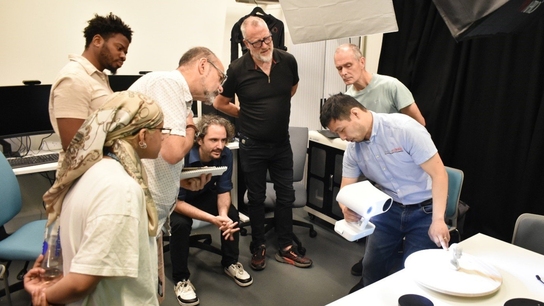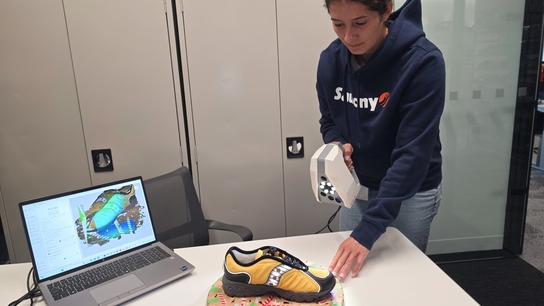Digitally preserving millennia-old bones with Artec Space Spider
Challenge: High up in the Himalayas, ancient bones that lay untouched for 2,000 years and were not excavated until the late 90s hold insights into the lives of a people about whom relatively little is known. Experts from the German Archaeological Institute (DAI) work to share this discovery with the world.
Solution: Artec Space Spider, Artec Studio
Results: Using Artec Space Spider, high-resolution models of the specimens were digitized for the first time, revealing fascinating clues into the lives and culture of the people in ancient Nepal.
Mention Nepal, and people usually think of Mount Everest, arguably the best known of the seven natural wonders of the world. If you talk about ancient history, this probably evokes images of Egypt, ancient Rome, countries further east, or South America with its Mayan civilization and pyramids of its own. It was not in any of these places though, that the German Archeological Institute (DAI) made an exciting archeological find in the early 1990s. It was in Nepal.

Khinga-Kalun, Nepal, where the discovery was made. Image courtesy of the German Archaeological Institute (DAI)
In one of the most remote regions of the country, the Mustang district, the Institute uncovered a trove of remarkably well-preserved animal and human remains dating back about 2,000 years. The bones were discovered beneath the ruins of a castle, in a chamber roughly seven meters long and two meters wide. This was at a site nestled high up in the Himalayas, some 3,000 meters above sea level – challenging conditions for any sort of work.
It would take nearly a decade for archeologists to excavate the site in three phases, between 1991 and 1999. The technology available at that time could not deliver the digitization capabilities that present-day 3D scanning technology is able to. The time has now come to revisit this remarkable discovery.

The trove of bones was found in a chamber beneath the ruins of an ancient castle. Image courtesy of the German Archaeological Institute (DAI)
Dr. Julia Gresky, the Institute’s anthropologist, and Monice Timm, who assisted during research on the project, are digitizing the specimens. Dr. Gresky acknowledges that, during its rich history dating all the way back to 1829, the German Archaeological Institute has done some impressive things. But even she describes this particular find as “very special.”
As she so eloquently put it, “The job of an anthropologist is to unearth clues to past civilizations – to let the bones speak, as it were.”
According to Dr. Gresky, bones are often discovered in hundreds, or even thousands of fragments which have to be glued back together in a painstaking process. The Nepalese bones, however, had lain untouched for over 2,000 years, almost perfectly preserved, hoarding their secrets until now.

The 2,000-year-old animal and human remains were very well-preserved. Image courtesy of the German Archaeological Institute (DAI)
Evidence suggests that the chamber was used for about two hundred years starting around 200 BCE. Dr. Gresky estimates that in the two thousand-odd years since, conditions in the room must have remained relatively constant, keeping the bones more or less intact. Also, the entire Mustang region is an ancient forbidden kingdom. In fact, until as recently as 1992, the Upper Mustang district was a restricted military zone closed off from the rest of the world. Which perhaps explains why there was relatively little interference with the site.

Monice Timm processes the 3D scan of a skull from the site in Artec Studio. Image courtesy of the German Archaeological Institute (DAI)
For Timm, it’s the historical significance of the find that sets it apart. The bones themselves tell the personal stories of a few individuals, but they also provide vital clues into the migrations and the cultural history of the people of Northern Nepal. Did they, for instance, get their influences from the Middle East, India, or Southern Nepal? The discovery adds a few more pieces to the puzzle and contributes to the sparse body of historical knowledge about this particular area.
Given how important the find was, the decision was made to go beyond the usual photography and X-rays or CT scans. They decided to properly digitize the bones and create accurate 3D models of them. Timm had worked with different solutions in the past, including several 3D scanners and even photogrammetry. She understood, better than most, that the task was easier said than done.
To achieve what they needed would require the right equipment. They couldn’t, for example, simply slap targets onto a 2,000-year-old cranium as many 3D scanners require, and then peel them off afterwards. Photogrammetry would require extensive preparation, dozens and dozens of carefully taken photographs, and even then, would not provide the accuracy and the dense point cloud that an advanced 3D scanner could. Thankfully, Timm had worked with Artec Space Spider before. She had experienced first-hand its ease of use and how well it captures objects of this size.
“With previous scanners I would even get angry because the process was so long and frustrating, even scanning a small bone used to take such a long time,” Timm said. “This is why I adore Artec scanners, they are so much faster and easier to use.”
Dr. Gresky agreed. “I haven’t spent a lot of time working with 3D scanners, and even for me, I had a lot of fun scanning with it. So Space Spider is really good – for both beginners and professionals,” she said.
Artec Space Spider is a lightweight, high-resolution 3D scanner based on blue-light technology. It weighs just 0.85 kg and, like Artec’s other scanners, is great for contactless scanning as it does not require the use of targets. The scanner was initially designed for use on the International Space Station and is perfect for capturing small to midsize objects as well as the intricate details of larger ones.

High-resolution textured scans from Artec Space Spider. Image courtesy of the German Archaeological Institute (DAI).
For this project, Space Spider’s 3D resolution of up to 0.1 mm and 3D accuracy of up to 0.05 mm would also provide the level of quality needed for the researchers to share the models with colleagues across the scientific community. The models would be sufficiently accurate for in-depth analyses that might, for example, demand measurements.
“You can observe certain things about pathology. Like a hand for example, you can examine its shape more closely and notice things you might have missed,” Timm explained.
The Space Spider unit used in this project was supplied by KLIB, a gold-certified Artec ambassador in Germany. The company provides solutions for a variety of 3D scan-based applications, and has extensive experience in supplying and providing technical support for 3D scanners.
“From the moment we became aware of the needs of this project, we knew that Space Spider would be perfect for the job,” said Knut Lehmann, KLIB CEO. “We knew they would need something easy and comfortable to use, but able to scan in high resolution, with a high level of accuracy and excellent color – Space Spider was it.”
The scanning process was fairly straightforward, even with the fragility of the specimens. Smaller, simpler bones were scanned in a matter of minutes, while those with more difficult shapes that required a different approach took longer. Ribs, clavicles, and vertebrae would take approximately 10-20 minutes, and skulls, about 30. Processing the scans in Artec Studio took about 20 minutes for the simpler bones, and anywhere from 30 minutes to 2 hours for skulls.

Detailed scans that even captured the degree of tooth decay. Image courtesy of the German Archaeological Institute (DAI).
The results so far speak for themselves. High-resolution scans have revealed lots of interesting details. Some of which you wouldn’t think would persist over two millennia. For example, one specimen actually reveals infection around the molar teeth. A reminder from ancient times perhaps, of the timeless wisdom of flossing regularly.
The project is ongoing, and what will be a rare collection of well-preserved and analyzed bones from that region of the world is steadily growing. At the moment, the focus is on analysis and digital preservation for scientific reference. Once their work is done, the Institute may look into creating the infrastructure to make the collection publicly available and further democratize this fascinating research.




